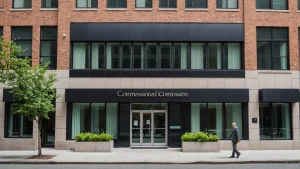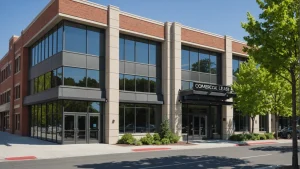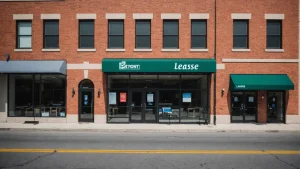A well-drafted Texas commercial lease agreement is essential for ensuring a smooth relationship between landlords and tenants. Whether you are renting office space, retail property, or industrial real estate, having a clear and legally binding lease agreement helps avoid future conflicts. In this guide, we will explore the intricacies of commercial lease agreements in Texas, what they typically include, and provide a free template for your use.

Save 80% of delivery management time
We handle everything:
- Dedicated operations manager
- Real-time tracking dashboard
- Automated customer notifications
- Urgent issue resolution
What Are Commercial Agreements?
A commercial agreement refers to a legally binding contract between two or more parties concerning business activities or commercial property. In the context of leasing, a commercial lease agreement is an essential document that outlines the terms and conditions under which a landlord rents out their property to a commercial tenant. These agreements differ significantly from residential leases, as they cater to the specific needs of commercial tenants and involve elements such as monthly rent, real estate taxes, and insurance coverage. Understanding the intricate details of a lease for commercial property is crucial for businesses to ensure their operational and financial aspects are adequately addressed.
Commercial agreements are designed to protect both the landlord and tenant by clearly defining each party’s responsibilities. They also help ensure that the leased property is used according to its intended purpose, whether it’s a retail space, office space, or industrial space. Unlike residential leases, commercial leases offer fewer legal protections for tenants, as it is assumed that commercial parties are more experienced in handling business contracts.
What Is a Texas Commercial Lease Agreement?
A Texas commercial lease agreement is a legally binding document used by landlords to rent out commercial property to businesses. The agreement sets forth the terms under which the tenant pays rent for the use of the property, including conditions for the lease term, leasehold improvements, and tenant’s obligations. The document is critical in formalizing the business relationship between the landlord and tenant and is essential for both legal protection and financial clarity. Understanding the intricacies of a leasing agreement for commercial spaces in Texas is vital for both parties to ensure a mutually beneficial arrangement.
Unlike residential tenants, commercial tenants are often responsible for covering more of the operating costs associated with the property, such as real estate taxes, utilities, and property expenses. Texas commercial leases can be either gross leases or net leases, where tenants may pay for various operating costs in addition to their rent. Understanding the structure of your commercial lease is crucial for avoiding unexpected costs down the road. To make an informed decision, comparing gross versus net leases is essential in identifying the commercial lease agreement that aligns with your financial and operational goals.
Additionally, it’s worthwhile to explore the different types of commercial leases available. Understanding the various types of commercial leases can provide crucial insights that help you choose the most suitable agreement for your specific business needs, protecting your interests and facilitating operational success.
What Are Included in a Texas Commercial Lease Agreement?
A Texas commercial lease agreement encompasses several critical elements that define the rights and obligations of both the property owner (landlord) and the tenant. Each component plays a vital role in ensuring that the lease is legally sound and protects the interests of both parties. Let’s take a detailed look at the key components of this agreement: Before signing the commercial lease, it is crucial to consider various factors that may impact your business. Understanding the terms thoroughly can help mitigate risks and ensure you are making the best decision for your commercial needs. For more insights, check out this article on what to look for in a commercial lease before finalizing your agreement.
1. Personal and Property Details
The first section of the lease identifies the landlord and tenant by their full legal names, along with any relevant business entity information if applicable. This section should also include contact information for both parties. In addition to identifying the people or companies involved, it is crucial to describe the leased property in detail. This includes the address, type of property (e.g., office space, retail space, industrial space), and any personal property that may be included in the lease, such as furniture or equipment that the tenant will have access to.
A clear description of the leased premises helps to avoid misunderstandings regarding the boundaries of the leased space, parking areas, or shared amenities within the same building. This section can also detail any leasehold improvements made to the property before the tenant takes possession.
2. Lease Term
The lease term specifies the length of time the tenant is entitled to occupy the property. Lease terms can range from short-term agreements (e.g., month-to-month leases) to long-term commitments of multiple years, depending on the nature of the commercial space and the tenant’s needs. This section should outline the start and end dates of the lease and any options for renewal or extension, giving both parties clarity on the lease space arrangement.
Many commercial leases include provisions for automatic renewal unless either party provides written notice within a specified time frame. Additionally, if the tenant or landlord wishes to terminate the agreement early, the lease may include an early termination clause that outlines the penalties or notice requirements involved. This flexibility is particularly valuable for commercial tenants whose business operations may change, leading them to need more or less space.
3. Abandonment
The abandonment clause is essential for protecting the landlord’s interest in the leased property. This section defines the conditions under which the property is considered abandoned by the tenant. For example, the lease may specify that if the tenant leaves the premises unoccupied for a certain number of consecutive days without notifying the landlord, it will be considered abandonment.
The clause should also describe the landlord’s rights in such situations, including the ability to re-enter the property, secure the premises, or lease the space to a new tenant. Abandonment clauses protect the landlord’s interest and allow for swift action to prevent financial losses or property damage.
4. Security Deposit
The security deposit acts as financial protection for the landlord in case the tenant fails to fulfill their obligations, such as paying rent or maintaining the property. In Texas, a typical commercial lease deposit is usually the equivalent of one or two months’ rent, though this can vary based on factors like the tenant’s credit history or the nature of the business.
This section of the lease should clearly outline the amount of the security deposit, how it will be held, and the conditions under which it can be retained or returned. For example, if the tenant causes damage to the rental property beyond normal wear and tear, or if they fail to pay rent, the landlord may be entitled to deduct these costs from the deposit. Texas law also requires landlords to return the deposit within a specific time frame after the tenant vacates the premises, so it’s crucial to include these details in the agreement.
5. Rental Amount
The rent amount section of a Texas commercial lease agreement is one of the most important clauses, as it dictates the financial terms of the agreement. This section should specify the base rent, how and when it will be paid (e.g., monthly, quarterly, or annually), and acceptable payment methods. Rent payments are typically due on the first of each month unless otherwise specified. Find out how commissions on commercial leases are typically calculated and what percentage is standard in rent agreements.
Before signing a commercial lease, it is crucial for tenants to understand all aspects of the agreement to avoid unexpected liabilities or costs. Evaluating the terms and conditions can prevent future disputes and ensure that both parties’ expectations are aligned. For further guidance, check out this comprehensive post on what to consider regarding a commercial lease before finalizing the agreement.
Additionally, the lease should outline any provisions for rent increases, which may occur annually or be tied to inflation or market conditions. Some commercial leases may also include percentage rent, particularly in retail spaces, where the tenant pays a base rent plus a percentage of their sales.
For net leases, the tenant may be responsible for paying additional expenses such as real estate taxes, insurance, and property expenses, while in a gross lease, these costs are typically covered by the landlord. The lease must clearly distinguish between these lease types to avoid confusion. Negotiating the terms of a commercial lease can be challenging, but understanding your options is crucial to ensuring a favorable agreement. For some helpful strategies, check out these negotiation tips for commercial lease agreements that can guide you through the process and enhance your chances of success.
6. Utilities
Responsibility for utilities such as electricity, water, and gas must be clearly outlined in the lease. In a net lease, the tenant typically covers all utility expenses, while in a gross lease, the landlord may include utilities in the rent. This section should specify which utilities are the responsibility of the tenant and which (if any) are handled by the landlord.
If the tenant’s business requires higher-than-usual utility usage, such as in manufacturing or industrial spaces, the lease might include provisions for metering and additional charges. This ensures that both the tenant and landlord understand their financial responsibilities when it comes to such costs.
7. Repairs and Maintenance
Repairs and maintenance are another crucial aspect of a commercial lease. This section should clearly define who is responsible for maintaining the leased premises. In most cases, commercial tenants are responsible for day-to-day maintenance and minor repairs, while landlords are tasked with maintaining the structure and major systems of the building, such as plumbing, electrical, and HVAC.
The lease should also clarify how repair costs are handled. For example, the tenant might be responsible for all repairs up to a certain dollar amount, while the landlord covers any costs beyond that. This section helps ensure that there are no misunderstandings regarding the tenant’s obligations or the landlord’s interest in keeping the property well-maintained.
8. Renovations
If the tenant plans to make leasehold improvements or renovations to the property, these should be outlined in the agreement. This section should specify whether the landlord’s permission is required for renovations and, if so, under what conditions it will be granted. Renovations might include building out office spaces, upgrading utilities, or modifying industrial spaces to suit the tenant’s specific needs.
The lease should also address whether the tenant is required to restore the property to its original condition at the end of the lease or if the leasehold improvements become the landlord’s property. This can have significant financial implications for both parties.
9. Other Inclusions
This final section covers any additional terms that don’t fit neatly into the other categories but are still crucial to the lease. Common inclusions might involve insurance policies (e.g., the tenant’s obligation to carry liability insurance), the tenant’s responsibility for damages, and specific restrictions on how the property can be used.
For example, if the tenant is renting space in a retail store or office building, the lease might restrict the types of businesses that can be operated on the premises. This protects the landlord’s investment and ensures that the property is used in a manner that aligns with its intended business purposes.
Disclosures
Under Texas law, landlords are required to make certain disclosures to tenants to comply with state and local laws. These disclosures are intended to protect tenants and ensure transparency in the leasing process. Here are some common types of disclosures that may be included in a Texas commercial lease agreement:
Lead-Based Paint Disclosure: For buildings constructed before 1978, landlords must inform tenants of any known lead-based paint hazards. This is particularly important for tenants operating in office buildings or retail stores located in older structures. Tenants must be provided with a lead-based paint pamphlet and acknowledgment of the disclosure.
Criminal Activity: A clause prohibiting illegal activities on the property should be included, informing tenants that engaging in criminal behavior or permitting others to do so on the premises is strictly prohibited. This disclosure is essential for protecting both the landlord’s interest and the safety of other tenants or businesses operating within the same building.
Third-Party Representation: Texas law requires that landlords provide tenants with information about any third-party representatives who are authorized to act on the landlord’s behalf. This includes property managers, leasing agents, or others responsible for maintaining the property. Tenants should also be informed of their rights if the landlord fails to make necessary repairs.
Who Needs a Texas Commercial Lease Agreement?
Any individual or business looking to rent commercial space in Texas should use a commercial lease agreement. This applies to landlords renting office buildings, retail stores, or industrial spaces, as well as tenants looking to occupy such properties for business purposes. Both parties benefit from having a clear understanding of the terms, as it prevents disputes over issues like rent increases, maintenance responsibilities, or the tenant’s obligation to provide proper notice before terminating the lease.
What You Can Use a Texas Commercial Lease Agreement for?
A Texas commercial lease agreement is highly versatile and can be used for various types of commercial properties. Whether you’re renting retail space, office space, or industrial space, a comprehensive lease agreement helps formalize the relationship between you and your tenant or landlord. The agreement is suitable for:
Renting out retail stores in shopping centers
Leasing office space in high-rise buildings
Offering industrial space for manufacturing or storage purposes
Renting commercial properties for business operations
Do Commercial Leases Need to Be Notarized in Texas?
While it is not required by law to notarize a commercial lease agreement in Texas, having the document notarized can provide an added layer of legal protection. Notarization ensures that both parties have entered into the legal agreement voluntarily and that their signatures are verified. However, lease agreements are still legally binding without notarization, as long as both parties have signed the document.
Free Texas Commercial Lease Agreement Template
To help you get started, we offer a free commercial lease template specifically designed for Texas. You can customize this lease agreement template to fit your specific needs, whether you are renting office buildings, retail stores, or industrial spaces. It covers all necessary legal provisions, including rent payments, tenant obligations, and leasehold improvements. Simply download the template, modify it as needed, and you’ll have a ready-to-use legal document for your leased premises.
iProperty Management’s Free Texas Commercial Lease Agreement Sample

FAQs About Texas Commercial Lease Agreements
1. How Long Can a Commercial Lease Term Be in Texas?
There is no legal maximum limit for the duration of a commercial lease term in Texas. Lease terms can vary from short-term agreements, such as month-to-month leases, to long-term contracts that span several years. The length of the lease depends on the needs of the tenant and landlord, and any renewal or extension options should be clearly outlined in the lease.
2. Can a Commercial Lease Be Broken Early in Texas?
Yes, a commercial lease can be broken early in Texas, but doing so often comes with financial penalties or legal consequences, depending on the terms of the lease. Many Texas commercial lease agreements include an early termination clause that outlines the conditions under which the lease can be ended before the agreed-upon term, such as providing proper notice or paying a fee. In the absence of such a clause, breaking the lease early could result in the tenant being responsible for the remaining rent payments or other costs until the landlord finds a new tenant for the leased property.
3. What Is the Difference Between a Gross Lease and a Net Lease?
In a gross lease, the tenant pays a fixed rent amount, and the landlord covers most or all property-related expenses, including taxes, insurance, and maintenance. In contrast, a net lease requires the tenant to pay not only the rent but also a portion of these additional costs, such as real estate taxes and property expenses. Depending on the agreement, tenants may encounter different types of net leases, such as a triple net lease, where they bear the full responsibility for taxes, insurance, and maintenance costs.
Final Thoughts on Texas Commercial Lease Agreements
A well-structured Texas commercial lease agreement is essential for both landlords and tenants to clearly outline their rights and responsibilities. With various components like the lease term, rent amount, and tenant’s obligations, this legal document serves to protect both parties and ensures that the leased property is used appropriately. Using a free template can save you time and money, while still allowing for customization based on your unique needs.
Ensure your business purposes are safeguarded with a properly drafted commercial lease agreement tailored for the Texas real estate market.






























